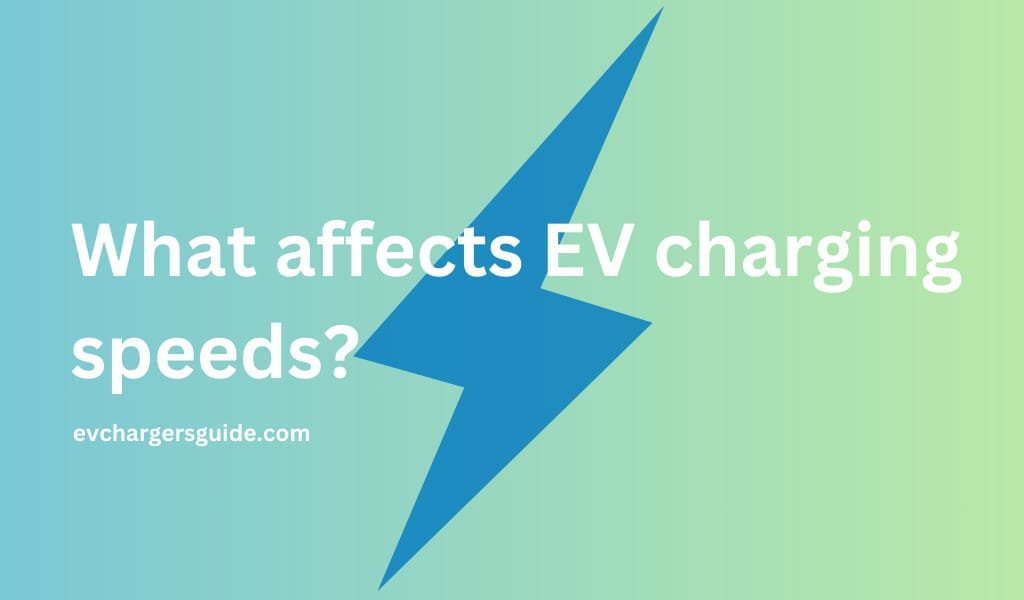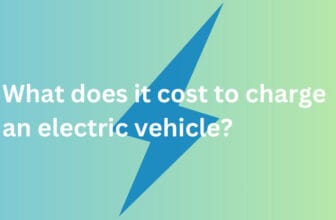
Now if you have researched more on charging speed offered by an EV charger at various power outputs, you still see at the same power output different EVs charge at different speeds right… Even the same brand and model of EV charge at different speeds.
Yes, it is true. You may wonder how..? That’s what I will show you here.
Looking at how EV charging works, technically there are various factors that affect the charging speed, which will be different with different EVs after the usage. When comparing charging speed for Brand new cars won’t show any difference but after using it, it will.
In This Article:
Understanding the Factors Affecting Charging Speed
It is obvious that EV charging speed will vary by EV charger’s power output and type of power output i.e. AC or DC.
But when using the same power output, the most important factor which affects charging speed is vehicle efficiency. The other factors are vehicle’s battery capacity (i.e. total kW storage capacity), type of battery used, vehicle’s charging configuration, battery temperature conditions, State of Charge i.e. charge level of battery and battery health.
Here’s the detail of each,
1) Electric Vehicle’s Efficiency
This is the most important factor affecting charging speed of any electric vehicle. Now when we consider same power output of EV charger charging different EVs and measuring charging speed in terms of range added per hour of charging then the efficiency of electric vehicle is most important factor affecting charging speed.
This can be with same brand and model of EVs or a different brand and model of EVs. No matter the same amount of power is being added to two different EVs but range added will come to different figures.
This is because each EV has it’s own efficiency to use the power stored in battery. It’s similar with gasoline vehicles in this way. Just like how gas powered vehicles provide different range per gallon like miles per gallon of gasoline, electric vehicles have miles per kWh.
So for each kWh added to electric vehicle how many miles it can run depends on how efficient the vehicle is to convert the battery power (kWh) to the distance it can travel. So accordingly the range adding per hour of charging will also be different, i.e. range added per hour of adding kilowatts will be different with different EVs.
I hope you got this point. Now let’s see other factors affecting charging speed.
2) EV charger’s power output:
Depending on how much power output the EVSE provides affects directly on charging speed of the EV. It is very simple to understand. Charger with 3.8kWh power output will charge the EV at slower rate the charging with 11.6kWh power output. It applies to both AC and DC chargers.
3) Type of power output AC or DC:
There are three levels of EVSE in market, Level 1, Level 2 and Level 3.
Level 1 and Level 2 are AC chargers that work at 110V/120V input power and 240V input power respectively. While Level 3 chargers are DC chargers work at 400V and above input power.
So to charge from 20% to 80% AC chargers charge at slower rate ranging from 6-8 hours while DC chargers charge at fast rate ranging from 10 mins to 30 mins.
Another factor affect DC charge to charge fast is, DC charging bypasses the vehicle’s onboard charger AC charging has to pass through vehicle’s onboard charger. Because EV’s battery always stores power in DC form, so to convert AC charging power to DC it passes through onboard charger. While there’s no such requirement while charging with DC charging. DC charger directly charges the vehicle battery without any interference.
Here’s a detailed guide you will find helpful on types of EV charger by speed of charging with all important metrics like power input, power output, range added per hour of charging and speed of charging.
4) Vehicle’s battery capacity (Total storage capacity in kWh):
Simply higher the capacity, longer the time it will take to complete the charging. This also affects the % State of Charge level, which will be discussed in SoC section.
5) Type of battery used in EV:
However, it’s Lithium-ion battery used in all EVs. But still there are various types of Lithium-ion batteries. All has different chemical structures and so the rate at which it will charge is also different.
6) Electric Vehicle’s onboard charger configuration:
Now, what’s maximum power EV’s onboard charger accepts will affect the charging speed. Mostly charging at 32A to 40A at 240V is the maximum power supported by any EV’s onboard charger, so there’s no point charging at higher power if the EV anyway accepts the maximum supported rate.
7) Vehicle’s battery temperature:
To facilitate the charging, the battery temperature should be under a certain limit, it is one of the factors affecting charging speed even among the same vehicle configuration. It shouldn’t be too hot or too cold. It works best when temperature is around 25°C.
At extreme temperatures, it will also affect the battery health. So vehicle’s BMS restricts the charging speed to protect the battery at extreme temperatures. And also how the energy stored in battery won’t allow the charging at normal speed at extreme temperatures (more details in later section in this article).
8) Battery’s State of Charge (SoC):
Now the charge level of battery also affects the speed of charging. SoC below 10% and above 80% will reduce the charging speed to protect the battery cells. This is directly proportional to the total battery capacity (i.e. kW storage capacity).
Charging speed between 20% to 80% is the highest in the cycle. After 80%-100% it will take almost the same or double the time as of charging from 20%-80%. This mechanism is purely to protect the battery. Because at too low and too high State of Charge, a faster charging speed degrades the battery more.
9) Battery health:
So by time charging and discharging the battery, degradation will happen anyway. The degradation of battery affects the battery cells and battery material affecting the speed at which it charges and discharges. It also affects the amount of power it stores over time.
However, there are best practices of charging to reduce the degradation to the least, but degradation will anyway happen over time. Battery degradation is kind of physical and chemical deformation of the battery material. So it will anyway affect charging speed negatively over time.
So these were the factors which affect the charging speed of any Electric Vehicle. Now I am going to show you a bit of technical background behind how this happens.
A Little Bit of Technical Background
You may know that the power is like a flow of water inside a pipe and charging is like filling up a water tank – but if you don’t know then that’s how it is in simple terms : )
Now we are providing the same water flow (power) but different water tanks (EVs) fill up at different speeds! And more funny is over time this speed varies with the same water tank (EV)…
At first sight, this seems strange… But the thing is there’s more complexity to it than how simple it seems.
Electricity is simply the flow of electrons flowing from high potential to low potential. When you charge your EV, this flow of electrons from a power source (through EVSE) to your EV gets stored in the EV’s battery, and we say EV is charging (actually it’s the battery!).
Now this storage of electrons in your EV’s battery is not that simple like storing water in water tank. There’s particular mechanism to it.
This electrons or potential energy actually stores in the battery in the form of chemical energy at the Anode (+ve node) of the battery.
It involves cathode (-ve node of battery) which first acceps the potential energy and electrolyte through which the energy is transferred to Anode. Then at Anode (+ve node of the battery) where this energy gets stored. (Shown in video below)
Now to understand further how it happens, it’s more technical and very few really grind further. So I’m skipping it explaining here considering the majority of users. But if you want to understand, here you go.
Video Source Credit: www.energy.gov
Now to facilitate this process with the highest efficiency, it requires the battery to be in certain suitable conditions. The conditions include battery temperature, the present State of Charge of the battery and overall health of the battery’s material.
These all factors affect the material of the battery ultimately. Yes, battery cells behave differently at different temperatures and different charge levels. And the process of charging and discharging the battery anyway affects the battery cells. So it won’t remain the same as of a brand new ones.
And it is actually the battery material that stores this potential energy and releases it. So by time, it affects the speed of charging (and even the speed of release when you accelerate… Yes!).
That’s why even the EVs of the same brand and model can show different charging speeds.
Even your own EV will show different speeds of charging over time because how it is used has significantly affected the battery’s material conditions.
Now I hope you have enough idea as to why charging speed varies between various EVs and even with your EV over time.
I tried to make the article rooted in the science behind it yet simple for everyone to understand. Let me know in the comments if I have missed something important, I appreciate that. Or let me know if you have any doubts I will be glad to help.
See you in the next article!

![What is the cost to install Tesla charger at Home? [Detailed Guide]](https://evchargersguide.com/wp-content/uploads/2023/12/how-much-does-it-cost-to-install-tesla-home-charger.jpg)


![Tesla Charge Stats Tesla app [Complete Guide] | Tesla App Not Showing Charging Stats [Fixed!]](https://evchargersguide.com/wp-content/uploads/2023/12/Tesla-app-charge-stats.jpg)













Now I Understood. I earlier thought it’s just battery capacity affecting charging time. But got it. Well informed post.
Thanks Jennifer! You got it right. Glad this article helped you to expand your EV charging horizons…
Oh ok, DC chargers skip on board charger that’s why they are fast.. interesting!
Yes, DC chargers or Level 3 chargers skip onboard charger in EV and most importantly they are very high powered ones operate at 400V and above charges the battery at very fast pace. In around 30 mins you will have your EV ready with 80%-90% charge level.
Very much informative especially the scientific background .. I liked it
Appreciating your comment. Thanks!
Ok.. that’s why. I have two Tesla model 3s in my family. Many times I start charging both together but sometimes it completes charging at same time and sometimes I saw it charges at different pace. Now I knew there are many other factors affecting charging speed.